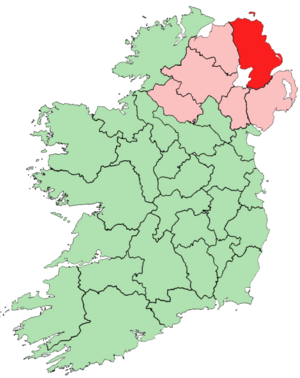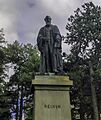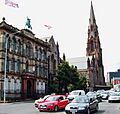List of Grade B+ listed buildings in County Antrim facts for kids
This article is about special buildings in County Antrim, Northern Ireland, that are officially protected because they are very old or have unique designs. These buildings are called "listed buildings," and the ones we're focusing on are given a "Grade B+" status. Think of it like a special award for buildings!
In Northern Ireland, a listed building is a structure that the government decides is very important because of its history or its architecture (how it's designed). Grade B+ buildings are those that are almost as important as the very top "Grade A" buildings. They might have a few small changes or additions that stop them from being Grade A, but they are still much more special than regular "Grade B" buildings. They often have amazing features, cool interiors, or are in beautiful natural settings.
Protecting these buildings started a bit later in Northern Ireland compared to other parts of the UK. The first laws to protect them came out in 1972, and the current rules are from 1991. The Northern Ireland Environment Agency (NIEA) is the group in charge of finding and listing these special buildings. They look for buildings that have "special architectural or historic interest."
The NIEA began its first big search for important buildings in 1974, finishing in 1994. Since then, they've started a "Second Survey" to update all the information and check everything again. This survey helps them keep track of both listed and unlisted buildings in a public database. They use specific rules to decide if a building is important enough to be listed.
Once a building is listed, it's protected! This means you can't make big changes to its structure or its old features without getting special permission from the local authorities. There are about 8,500 listed buildings in Northern Ireland, which is about 2% of all buildings. Out of these, around 580 are Grade B+.
County Antrim is a large area, covering about 2,844 square kilometers (1,100 square miles), and it has a population of around 616,000 people. This county is home to 157 Grade B+ listed buildings!
Contents
What Makes a Building Special?
Buildings get listed for many reasons. It could be because they are very old, show a unique style of architecture, or are connected to important historical events or people. For example, a building might have been a famous person's home, or it might be one of the last examples of a certain type of construction.
Protecting Our Past
Listing buildings helps us protect our history and culture. These buildings are like giant storybooks, telling us about how people lived, worked, and built things in the past. By keeping them safe, we make sure that future generations can also learn from and enjoy these amazing structures. It's like preserving a piece of art or a rare book, but on a much bigger scale!
Cool Grade B+ Buildings in County Antrim
County Antrim has many fascinating Grade B+ listed buildings. Here are just a few examples that show the variety of structures protected:
Historic Churches
Many churches are listed because of their beautiful architecture and long history.
- Our Lady and St. Patrick R.C. Church in Ballymoney is a beautiful church with a rich past.
- St Olcan's R.C. Church in Armoy, Ballymoney, is another significant religious building.
- Ballintoy Parish Church in Ballintoy Demesne is known for its historic charm.
- St John’s C. of I. in Islandmagee, Larne, is a lovely church that has been protected.
- St Cedma’s C of I Church in Larne is an important landmark in the area.
- First Presbyterian Church in Antrim is a key historical church.
- St Comgall's R.C. Church in Antrim is another example of a protected place of worship.
- Christ Church in Ballynure is a Grade B+ listed church.
- St. Patrick's R.C. Church in Belfast is a prominent church in the city center.
- Donegall Square Methodist Church in Belfast is a grand building in a busy area.
- Sinclair Seaman's Presbyterian Church in Belfast has a unique history connected to sailors.
Grand Houses and Castles
Some large homes and even castles are listed for their architectural beauty and historical importance.
- Moore Lodge in Ballymoney is a country house that has been recognized for its special features.
- Drumnasole House in Carnlough, Ballymena, is a beautiful country house.
- Peter Stott Martin House (once known as Craigdun Castle) in Cullybackey, Ballymena, is a grand old house.
- Belfast Castle is a famous landmark on the Antrim Road, offering great views and a fascinating history.
Unique Structures and Landmarks
Not all listed buildings are houses or churches; some are bridges, towers, or even old mills!
- Turnley's Tower in Cushendall is a historic tower that stands out.
- Glendun Viaduct is an impressive bridge structure in Glendun.
- Larne Town Hall is an important civic building in Larne.
- The Thatch Inn in Broughshane is a historic public house, often recognized by its traditional thatched roof.
- Arthur Cottage in Cullybackey, Ballymena, is a museum that preserves a traditional Irish cottage.
- Railway Viaduct in Randalstown, Antrim, is an old railway bridge that is now protected.
- Patterson's Spade Mill in Templepatrick is a unique mill that shows how tools were made in the past.
- Blackhead Lighthouse in Whitehead is a famous lighthouse that helps guide ships.
- Carrickfergus Borough Council Town Hall is a significant building in Carrickfergus.
- King's Bridge in Belfast is an important bridge structure.
- Parliament Buildings at Stormont Estate in Belfast are where the Northern Ireland Assembly meets, and they are very important historically and architecturally.
- Stormont Castle is another historic building on the Stormont Estate.
- Albert Memorial Clock in Belfast is a well-known clock tower in the city.
- The Courthouse, Crumlin Road in Belfast is a grand old court building.
- Clonard Monastery in Belfast is a large and historic monastery.
Images for kids
See also


















































































